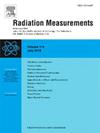空气-水接触系统中实验参数对氡浓度影响的评价
IF 2.2
3区 物理与天体物理
Q2 NUCLEAR SCIENCE & TECHNOLOGY
引用次数: 0
摘要
氡是一种自然产生的放射性气体,被认为是导致非吸烟者肺癌的首要原因。在水和空气相相互作用的系统中,经常研究重大的环境和健康影响。氡行为的准确建模在实验室研究中是至关重要的。然而,实验设置的偏差会增加氡知识的不确定性。研究了空气-水接触系统中关键实验参数对氡浓度的影响。具体而言,研究评估了采样点,采样方法和设置内的总水量的影响。实验结果表明,无论实验装置如何,氡气的扩散行为都没有显著变化,其浓度值和积累趋势相似。这项研究证实,这些实验条件的变化不会影响氡输运系数和以前工作中获得的模型。本文章由计算机程序翻译,如有差异,请以英文原文为准。
Assessment of experimental parameters influence on radon concentration in systems with air-water contact
Radon is a naturally occurring radioactive gas, considered the first lung cancer cause in non-smokers. The significant environmental and health implications are often studied in systems where water and air phases interact. Accurate modeling of radon behavior is critical in laboratory research context. However, deviation in experimental setups can increase uncertainties in radon knowledge.
This study investigates the influence of key experimental parameters on radon concentration in systems with air-water contact. Specifically, the study evaluates the impact of water sampling points, the sampling method and the total water volume within the setup.
The experimental results demonstrate there are no significant variations in the behavior of radon gas diffusion as similar concentration values and accumulation trends are observed regardless of the experimental setup. This research confirms that changes in these experimental conditions do not compromise radon transport coefficients and models obtained in previous work.
求助全文
通过发布文献求助,成功后即可免费获取论文全文。
去求助
来源期刊

Radiation Measurements
工程技术-核科学技术
CiteScore
4.10
自引率
20.00%
发文量
116
审稿时长
48 days
期刊介绍:
The journal seeks to publish papers that present advances in the following areas: spontaneous and stimulated luminescence (including scintillating materials, thermoluminescence, and optically stimulated luminescence); electron spin resonance of natural and synthetic materials; the physics, design and performance of radiation measurements (including computational modelling such as electronic transport simulations); the novel basic aspects of radiation measurement in medical physics. Studies of energy-transfer phenomena, track physics and microdosimetry are also of interest to the journal.
Applications relevant to the journal, particularly where they present novel detection techniques, novel analytical approaches or novel materials, include: personal dosimetry (including dosimetric quantities, active/electronic and passive monitoring techniques for photon, neutron and charged-particle exposures); environmental dosimetry (including methodological advances and predictive models related to radon, but generally excluding local survey results of radon where the main aim is to establish the radiation risk to populations); cosmic and high-energy radiation measurements (including dosimetry, space radiation effects, and single event upsets); dosimetry-based archaeological and Quaternary dating; dosimetry-based approaches to thermochronometry; accident and retrospective dosimetry (including activation detectors), and dosimetry and measurements related to medical applications.
 求助内容:
求助内容: 应助结果提醒方式:
应助结果提醒方式:


